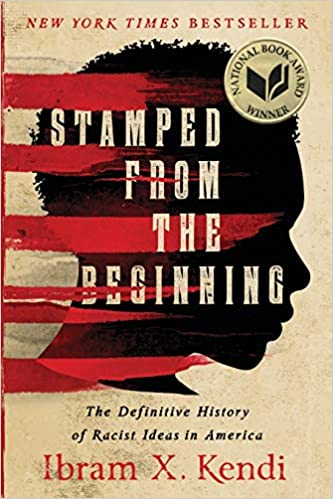Books & Culture
The Book You Need to Fully Understand How Racism Operates in America
Before he wrote "How to Be an Antiracist," Ibram X. Kendi's "Stamped from the Beginning" examined the history of overt and covert bigotry

For years, we’ve been taught that racism is rooted in ignorance and can be combated by education. That’s not exactly true. Racism was constructed by highly educated men, and used as a conduit to gain and sustain power, as well as financial gain. To truly address racism, (white) readers must move beyond just understanding how it operates, and come to terms with how racial disparity is built into the very foundations of the United States.
Highly respected race and history scholar Ibram X. Kendi’s How to Be an Antiracist is one of the books that has been making rounds on coffee tables as of late. In Kendi’s most recent publication, the professor of race and international relations at American Universtity pushes readers who claim not to be racist to become anti-racist—“people who support ideas and policies affirming that racial groups are equals,” despite their differences. Instead of exploring American’s racist behavior, Kendi examines his own racist practices, which is imperative to combating racism. With this, Kendi is being the change that he wants to see. While How to Be an Antiracist is an informative and necessary read, it is his National Book Award-winning, Stamped from the Beginning: The Definitive History of Racist Ideas in America that deserves extra attention. If we want to uproot the current racist system, it’s mandatory that we understand how racism was constructed. Stamped does just that.
Stamped from the Beginning takes its name from an 1860 speech given by former Mississippi senator Jefferson Davis, who announced that the inequality of white and Black races was “stamped from the beginning.” Kendi centers his work on two questions that people have historically asked themselves about racial inequality: One, what are Blacks doing wrong? Two, what are “we” doing to the Blacks?
Kendi identifies the two camps as segregationists and assimilationists. Segregationists are those who blame Black people for racial disparities. Assimilationists—a group that includes Abraham Lincoln—recognize that discrimination exists, but also rest on an assumption that Black people are inherently lesser. Segregationists attract the most criticism, while assimilationists may appear to be nonracists. “So many prominent Americans,” Kendi writes, “many of whom we celebrate for their progressive ideas and activism, many of whom had very good intentions, subscribed to assimilationist thinking that has also served up racist beliefs about Black inferiority.” In other words, assimilationists promote freedom but neglect equality.
Assimilationists promote freedom but neglect equality.
For instance, noted freedom fighter William Lloyd Garrison, editor of the 19th-century abolitionist newspaper the Liberator, and a founder of the American Anti-Slavery Society, explained his opposition to slavery by arguing that it had degraded Black people. In his introduction to the Narrative of the Life of Frederick Douglass, he wrote: “Nothing has been left undone to cripple their intellects, darken their minds, debased their moral nature, obliterate all traces of their relationships to mankind.” Even Frederick Douglass himself, Kendi argues, held some racist views. Racism is such an indelible part of American history that even the opponents of slavery—even the former slaves—based their beliefs on an assumption of Black inferiority.
Let’s look at another alleged friend of Black folks, President Theodore Roosevelt. Because Roosevelt expressed “interest” in Howard University by dedicating new buildings to the campus, funded by Congress, many believed that he was antiracist. But his support came from a belief that buttressing HBCUs would reduce lynchings, because lynching was a response to Black criminality. It makes one wonder how Roosevelt would have reacted had he witnessed the civil disobedience at HBCUs where students made attempts to disrupt Jim Crow.
Recently, the House of Representatives passed the George Floyd in Policing Act of 2020. This broad bill bans police chokeholds, a tactic used by Daniel Pantaleo to kill Eric Garner in 2014. The new bill will also track police misconduct, and prohibit certain no-knock warrants, a method used to murder Breonna Taylor. Also, television companies are removing films, and shows. Record labels are removing the term “urban” from its hip-hop and R&B departments. NFL commissioner Roger Goodell apologized for not listening to NFL players earlier, yet he said nothing about Colin Kaepernick. All of this sounds good, but none of the above measures uproot the current system that’s in place. These actions are maneuvers by skilled assimilationists.
Exercising subtle and effective racism requires a critical thought process and potent language, which usually comes from years of rigorous study. It must be noted how Lee Atwater explained to the Reagan Administration how to use abstract racist language without sounding racist to the public. These types of conversations continue behind closed doors. By not recognizing harmful language, many Blacks unknowingly assisted in the passing of the “tough on crime law,” written by Joe Biden and signed into law by Bill Clinton in 1994. The “tough on crime law” was one of the main contributors to mass incarceration, which overwhelmingly affects minorities.
It’s hard to distinguish between authentic goodwill and those motivated by self-aggrandizement.
We must also be critical of Black assimilationists. Recently, it was alleged that CNN anchor Van Jones helped law enforcement and White House staff write the George Floyd in Police Act of 2020. Jones alleged involvement in constructing a loose police reform bill, parallels the controversial views of Booker T. Washington. During Washington’s 1895 Atlanta Compromise speech, the Hampton University graduate suggested that Blacks should accept segregation, and focus on vocational training as opposed to academic pursuits. Washington’s theory was that corporate America would not allow Blacks into professional spaces. While there was some truth to Washington’s philosophy, he was also telling Blacks to deny their constitutional rights, particularly the 14th amendment, which is exactly what systemic racism does: deny equality to Blacks.
With current civil unrest in the U.S., educated and even well-meaning activists, senators, mayors, governors, CEOs, etc. will make promises, and may have good intentions to stand on their promises. It’s hard to distinguish between authentic goodwill and those motivated by self-aggrandizement. With this, a thorough study of Stamped from the Beginning prepares readers to be aware of abstract language, examine their own racist views, and have a better understanding of how racists, and assimilationists operate.









